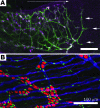Building a second brain in the bowel
- PMID: 25664848
- PMCID: PMC4362233
- DOI: 10.1172/JCI76307
Building a second brain in the bowel
Abstract
The enteric nervous system (ENS) is sometimes called the "second brain" because of the diversity of neuronal cell types and complex, integrated circuits that permit the ENS to autonomously regulate many processes in the bowel. Mechanisms supporting ENS development are intricate, with numerous proteins, small molecules, and nutrients that affect ENS morphogenesis and mature function. Damage to the ENS or developmental defects cause vomiting, abdominal pain, constipation, growth failure, and early death. Here, we review molecular mechanisms and cellular processes that govern ENS development, identify areas in which more investigation is needed, and discuss the clinical implications of new basic research.
Figures



References
-
- Wood JD. Taming the irritable bowel. Curr Pharm Des. 2013;19(1):142–156. - PubMed
-
- Heuckeroth RO. Hirschsprung disease. In: Faure C, DiLorenzo C, Thapar N, eds. Pediatric Neurogastroenterology: Gastrointestinal Motility And Functional Disorders In Children. New York, New York, USA: Springer; 2013:271–283.

